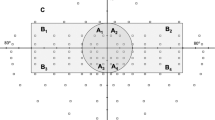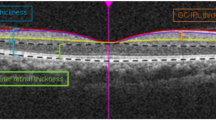Abstract
Background
The aim of this work is to study the possible association between retinal nerve fiber layer (NFL) thickness and driving ability.
Methods
Thirty-eight drivers including 22 HIV-positive (HIV+) and 16 age-matched HIV-negative controls participants underwent a full ophthalmologic evaluation, including assessment of retinal NFL thickness. In the undilated state with standard optical correction and under standard illumination they also completed a computer-based, wide field-of-view driving simulation in which they were to obey traffic laws, engage in crash avoidance, and pass slower automobiles. Crashes, speeding and traffic light tickets, and off-road excursions contributed to a weighted score of driving errors.
Results
HIV-seropositive participants had a significantly higher weighted error score than control participants (18.4 [9.2] vs. 11.1 [4.5], p = 0.006). NFL thickness was significantly correlated with driving errors (r = −0.51, p = 0.025); there was a trend for participants with a CD4 nadir <100 to have more errors than those with a nadir >100 (29.7 [13.2] vs. 19.3 [8.4], p = 0.056). The highest number of driving errors occurred in individuals with both CD4 <100 and NFL thickness <80.
Conclusions
Driving ability may be impacted by reductions in retinal nerve fiber layer thickness. Physicians should consider the potential impact that more complex ophthalmologic conditions in HIV-infected patients may have on driving performance.

Similar content being viewed by others
References
Freeman WR, Van Natta ML, Jabs D, Sample PA, Sadun AA, Thorne J, Shah KH, Holland GN, Grp SR (2008) Vision function in HIV-infected individuals without retinitis: report of the Studies of Ocular Complications of AIDS Research Group. Am J Ophthalmol 145(3):453–462
Plummer DJ, Sample PA, Arevalo JF, Grant I, Quiceno JI, Dua R, Freeman WR (1996) Visual field toss in HIV-positive patients without infectious retinopathy. Am J Ophthalmol 122(4):542–549
Geier SA, Nohmeier C, Lachenmayr BJ, Klauss V, Goebel FD (1995) Deficits in perimetric performance in patients with symptomatic human-immunodeficiency-virus infection or acquired-immunodeficiency-syndrome. Am J Ophthalmol 119(3):335–344
Geier SA, Kronawitter U, Bogner JR, Hammel G, Berninger T, Klauss V, Goebel FD (1993) Impairment of color contrast sensitivity and neuroretinal dysfunction in patients with symptomatic HIV infection or AIDS. Br J Ophthalmol 77(11):716–720
Shah KH, Holland GN, Yu F, Van Natta M, Nusinowitz S (2006) Contrast sensitivity and color vision in HIV-infected individuals without infectious retinopathy. Am J Ophthalmol 142(2):284–292
Mueller AJ, Plummer DJ, Dua R, Taskintuna I, Sample PA, Grant I, Freeman WR (1997) Analysis of visual dysfunctions in HIV-positive patients without retinitis. Am J Ophthalmol 124(2):158–167
Sample PA, Plummer DJ, Mueller AJ, Matsubara KI, Sadun A, Grant I, Freeman WR (1999) Pattern of early visual field loss in HIV-infected patients. Arch Ophthalmol 117(6):755–760
Kozak I, Bartsch DU, Cheng LY, Kosobucki BR, Freeman WR (2005) Objective analysis of retinal damage in HIV-positive patients in the HAART era using OCT. Am J Ophthalmol 139(2):295–301
Kozak I, Bartsch DUG, Cheng L, McCutchan A, Weinreb RN, Freeman WR (2007) Scanning laser polarimetry demonstration of retinal nerve fiber layer damage in human immunodeficiency virus-positive patients without infectious retinitis. Retina 27(9):1267–1273
Gomez ML, Mojana F, Bartsch DU, Freeman WR (2009) Imaging of long-term retinal damage after resolved cotton wool spots. Ophthalmology 116(12):2407–2414
Marcotte TD, Heaton RK, Wolfson T, Taylor MJ, Alhassoon O, Arfaa K, Grant I (1999) The impact of HIV-related neuropsychological dysfunction on driving behavior. J Int Neuropsychol Soc 5(7):579–592
Marcotte TD, Wolfson T, Rosenthal TJ, Heaton RK, Gonzalez R, Ellis RJ, Grant I (2004) A multimodal assessment of driving performance in HIV infection. Neurology 63(8):1417–1422
Marcotte TD, Lazzaretto D, Scott JC, Roberts E, Woods SP, Letendre S (2006) Visual attention deficits are associated with driving accidents in cognitively-impaired HIV-Infected individuals. J Clin Exp Neuropsychol 28(1):13–28
Dobbs AR, Heller RB, Schopflocher D (1998) A comparative approach to identify unsafe older drivers. Accid Anal Prev 30(3):363–370
Baldock MR, Mathias JL, McLean AJ, Berndt A (2006) Self-regulation of driving and its relationship to driving ability among older adults. Accid Anal Prev 38(5):1038–1045
Kay L, Bundy A, Clemson L, Jolly N (2008) Validity and reliability of the on-road driving assessment with senior drivers. Accid Anal Prev 40(2):751–759
Kozak I, Sample PA, Hao J, Freeman WR, Weinreb RN, Lee TW, Goldbaum MH (2007) Machine learning classifiers detect subtle field defects in eyes of HIV individuals. Trans Am Ophthalmol Soc 105:111–118, discussion 119–120
Heaton RK, Clifford DB, Franklin DR Jr, Woods SP, Ake C, Vaida F, Ellis RJ, Letendre SL, Marcotte TD, Atkinson JH (2010) HIV-associated neurocognitive disorders persist in the era of potent antiretroviral therapy: CHARTER Study. Neurology 75(23):2087–2096
Shechtman OCS, Awadzi K, Mann W (2009) Comparison of driving errors between on-the-road and simulated driving assessment: a validation study. Traffic Inj Prev 10(4):379–385
Lee H (2003) The validity of driving simulator to measure on-road driving performance of older drivers. Transp Eng Aust 8(2):89–100
Funding
National Institutes of Health (NIH) Grant No. EY007366. NOT-OD-09-060-Recovery Act Administrative Supplement for undergraduate summer research fund. MH 62512 - HIV Neurobehavioral Research Center (HNRC).
Author information
Authors and Affiliations
Corresponding author
Electronic supplementary material
Below is the link to the electronic supplementary material.
ESM 1
(DOC 22.5 kb)
Rights and permissions
About this article
Cite this article
Cheng, S., Klein, H., Bartsch, DU. et al. Relationship between retinal nerve fiber layer thickness and driving ability in patients with human immunodeficiency virus infection. Graefes Arch Clin Exp Ophthalmol 249, 1643–1647 (2011). https://doi.org/10.1007/s00417-011-1735-4
Received:
Revised:
Accepted:
Published:
Issue Date:
DOI: https://doi.org/10.1007/s00417-011-1735-4




